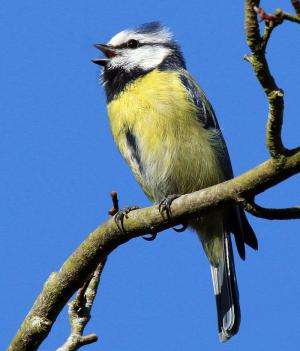Blue tits: Bad news for kids – parents do not defend their offspring at all cost

Do parents defend their offspring whenever necessary, and do self-sacrificing parents really exist? To answer this question, researchers of the University of Veterinary Medicine, Vienna examined defence behaviours of parent blue tits. They investigated whether birds would risk everything to protect their young from predators. Their conclusion: parents weigh the risks. It is not only the risk to the nestlings, but also their own risk that plays a role when defending their nests. The results were published in the journal Proceedings of the Royal Society B.
The degree to which parents sacrifice themselves for their children depends on a variety of factors. On the one hand nest predators pose a threat to the young and the parent birds. But also the time of hatching plays a role. Earlier studies have shown that birds born late in the season are more likely to be protected by their parents, as the adult birds often do not have the chance to produce replacement clutches. Older offspring also tend to be protected more readily than younger ones, as much more parental care and energy have already been invested.
"Studies on the risk behaviour of birds already exist. But there are only a few in which several factors have been investigated at the same time. We are upon the first showing how parents respond to more or less dangerous predators when defending offspring of different ages in the field says first author Katharina Mahr.
Risk research using predator models
Together with Herbert Hoi from the Konrad Lorenz Institute of Ethology they observed blue tit parents defending their nestlings aged between five and twelve days. The parents were confronted with different predators of varying threat levels. A stuffed sparrowhawk represented a predator with great risk to adult blue tits. A sparrowhawk is not considered dangerous for very young blue tits, as it cannot reach into the nest-box. However, sparrowhawks become more relevant predators for older nestlings. A rubber snake represented a predator of medium risk. Snakes are very dangerous for the young, but due to their low mobility represent a low risk to parents. A stuffed woodpecker was used as a third predator. Woodpeckers are able to open nest-boxes and therefore represent the greatest danger to very young nestlings, but not to older juveniles.
When exposed to a snake, blue tit parents attacked the predator. Since alarm calls against snakes have little effect, as snakes don't hear those calls, parents rather attack the enemy. Furthermore, snakes are less mobile than birds. A targeted attack is therefore the best choice with the lowest risk for the parents.
Direct attacks on predators are, according to Mahr, the riskiest behaviour bird parents can exhibit. When exposed to the sparrowhawk or the woodpecker, the parents neither attacked nor approached the predators. Instead, the parents responded with loud alarm calls. "Attacking a sparrowhawk is life-threatening for blue tits," Mahr points out. "That's why they probably do not attack. Their own risk is too high."
Blue tits keep cool
"Defence behaviour is apparently not based on rash decisions, but is subject to a cascade of considerations," Mahr concludes. The age of the nestlings seems to play a role in the less risky alarm calling strategy. Parents warned their twelve-day-old nestlings more often using alarm calls than their five-day-old offspring.
Moreover, nestlings are extremely dependent on their parents. "Self-sacrifice only happens, when the nestlings are able to survive on their own. Otherwise the sacrifice makes no sense", Mahr explains. "That's probably why parents defend older offspring more vigorously than young."
"Our findings could have general implications for the economy of risk management and decision-making strategies in living beings including humans. Humans do react rashly at times. But probably unconscious decisions don't always turn out to be the worst," says Mahr.
In the future, Mahr and Hoi would like to filter out the differences, if any, between maternal and paternal behaviours. The data have already been collected and must now be evaluated.
This study was based on field observations by Julia Thoma, who provided the first data for this project as part of her pre-academic paper for the project Sparkling Science.
More information: The article "Parental risk management in relation to offspring defence: bad news for kids" by Katharina Mahr, Georg Riegler and Herbert Hoi was published on 12th November 2014 in the journal Proceedings of the Royal Society B. DOI: 10.1098/rspb.2014.1670
Journal information: Proceedings of the Royal Society B
Provided by University of Veterinary Medicine—Vienna


















